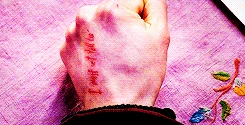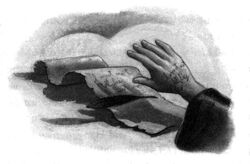- "He let out a gasp of pain. The words had appeared on the parchment in what appeared to be shining red ink. At the same time, the words had appeared on the back of Harry's right hand, cut into his skin as though traced there by a scalpel — yet even as he stared at the shining cut, the skin healed over again, leaving the place where it had been slightly redder than before but quite smooth... He looked back at the parchment, placed the quill upon it once more, wrote I must not tell lies, and felt the searing pain on the back of his hand for a second time; once again, the words had been cut into his skin, once again they healed over seconds later. And on it went. Again and again Harry wrote the words on the parchment in what he soon came to realise was not ink, but his own blood. And again and again the words were cut into the back of his hand, healed, and then reappeared the next time he set quill to parchment."
- — Harry Potter experiencing the Black Quill[src]
This Black Quill,[3] also known as the Blood Quill, was a cursed quill used as a torture device. It did not require ink, as it wrote with the blood of the person using it. It was invented by British Ministry of Magic employee Dolores Umbridge[1] some time in 1994.[4]
What the user wrote would be carved onto the back of their hand and the blood from the words sliced into the hand would be magically siphoned and used as ink on the parchment. The wound on the back of the hand would then heal, slightly redder than before, and then open up when the user wrote again. Continuous use of it would eventually scar the back of the hand. The quill was black, long, thin, and extremely sharp.[2]
Known use
- Dolores Umbridge: "You’re going to be using a rather special one of mine. Here you are. I want you to write I must not tell lies."
- Harry Potter: "How many times?"
- Dolores Umbridge: "Oh, as long as it takes for the message to sink in."
- — Umbridge instructing Harry to use the quill[src]
During the 1995–1996 school year at Hogwarts School of Witchcraft and Wizardry, Dolores Umbridge was Defence Against the Dark Arts professor and High Inquisitor. As a method of punishment, she had students who displeased her write lines using the Black Quill,[2] which Professor Minerva McGonagall considered a "medieval method" of teaching.[5]

Harry Potter was one of the students upon whom Umbridge frequently forced this punishment, since he persistently claimed that Voldemort had returned during the Defence Against the Dark Arts classes, which the Ministry of Magic refused to believe. He used the Black Quill during many detentions, from 5:00 p.m. to well over midnight, until he acquired a scar on the back of his hand reading "I must not tell lies".[2]

Hermione Granger prepared a solution made of Murtlap Essence in order to help relieve the pain Harry suffered from using the Black Quill.[6] Lee Jordan was another student who was forced to use the Black Quill for mocking Educational Decree Number Twenty-Six.[7]
There were also many students Umbridge put into detention for using the Skiving Snackbox, claiming to have "Umbridge-itis", but failed to discover their secrets. It is unknown if she used the Black Quill to punish these students, though she failed to extract the true cause of their symptoms, and was forced to let them leave her class in droves.[8]
Legacy
- "You've been through all that persecution from the Ministry when they were trying to make out you were unstable and a liar. You can still see the marks on the back of your hand where that evil woman made you write with your own blood, but you stuck to your story anyway..."
- — A year after Harry Potter was punished with the Black Quill[src]

Harry's torturous detentions from Umbridge served as a symbol of her tyranny and the lengths to which she would go to silence him from telling the truth,[2] though it is never known whether other Ministry employees or even Cornelius Fudge himself were ever aware that she used these disciplinary actions.
It is possible that the Ministry was unaware of it and would not condone the usage, as when Umbridge prepared to use the Cruciatus Curse on Harry she said, "What Cornelius doesn't know won't hurt him", giving rise to speculation that Umbridge might be doing more than a few unlawful things behind her employer's back, the use of the Black Quill possibly included.[9] Furthermore, Percy Weasley, in a letter to his brother Ronald Weasley, described Umbridge as a "delightful woman", showing that he himself was totally ignorant of Umbridge's sinister nature.[10]
Due to the sadistic punishments he received from Umbridge for standing up to her, Harry hated Umbridge from the bottom of his heart, a hatred rivalling that which he initially felt towards Severus Snape. He loathed Umbridge's high, girlish voice and her wide, toad-like smile during his detentions, her denial of Harry's claims and the way she seemed to enjoy and take pleasure as he carved his hand and wrote in his own blood.[2]

However, Harry was convinced talking about the punishments he was forced to do wasn't a good idea. He stubbornly clung to the belief that this was a private battle of wills between himself and Umbridge. He didn't want to give in or give her the satisfaction of hearing that he had complained about it. Ron repeatedly suggested to report this to Professors McGonagall or Dumbledore. Harry refused on the belief that the former has not enough authority to override the punishment, while not wanting to bother with the latter for ignoring him.[2] This suggested that while Umbridge had enough authority to silence a teacher, she could not utilise the quill if the headmaster did not approve it, furthering the quill's illegality.
During the Christmas of 1996, Harry was visited at The Burrow by then-Minister for Magic Rufus Scrimgeour. The purpose of Scrimgeour's visit was to ask Harry to be the Ministry's "poster child"; that is, he would pop in and out of the Ministry from time to time and tell the public that the Ministry was doing the right thing in the war against Lord Voldemort. Scrimgeour tried to persuade Harry to work with the Ministry to create the image that "The Chosen One" was supporting them while they continued to get nowhere in capturing Death Eaters and putting the wrong people in Azkaban, to give an image of progress.[11]
To bribe Harry, Scrimgeour told him he could get him in contact with Gawain Robards, Head of the Auror Office, as Umbridge had told the Minister that Harry had an ambition to become an Auror. Upon hearing that Umbridge was still in Ministry employment, anger began to bubble at the pit of Harry's stomach. When Harry pointed out that Scrimgeour didn't care if he (Harry) lived or died as long as he created the illusion that the Ministry was doing well, he raised his right fist and showed Scrimgeour the scars of I must not tell lies Umbridge had forced him to carve into his own flesh, shining white on the back of his cold hand, and pointed out that the Ministry wasn't so keen to be friends during their campaign to discredit him and Dumbledore the previous year.[11]
Known users
- Harry Potter (multiple detentions during the 1995–1996 school year)[2]
- Lee Jordan (for mocking Educational Decree Number Twenty-Six)[7]
- Dumbledore's Army (following the group's discovery by Umbridge and the Inquisitorial Squad)
Behind the scenes
- The use of this torturous quill was described as "sick" by Harry Potter, Ron Weasley, and even Imelda Staunton, the actress that plays Dolores Umbridge in the film adaptations.
- In the film adaptation of Harry Potter and the Order of the Phoenix, all the Dumbledore's Army members had to use it after Cho Chang was forced into betraying them, for breaking Educational Decree Number Sixty-Eight; Cho alone was not required to use the quill as a result.
- The Black Quill is rather similar to a device in Franz Kafka's short story "In the Penal Colony", where inmates are tortured and executed with a crude device that carves the sentence into the convicted person's skin.
- Given the recent introduction of a blood pact into canon, which adds another layer to the question of what magical properties blood have in regard to magic, dark or otherwise, it is uncertain if signing a contract or other legal document with Umbridge’s quill would mean it is magically binding as well as legally, or if that would require additional spellwork.
- Before Rowling stated otherwise, fans believed that Black Quills were restricted items meant to be used for the signing of magically-binding documents (contracts, etc.). Umbridge's use of them on students was therefore highly illegal.
Appearances
- Harry Potter and the Order of the Phoenix (First appearance)
- Harry Potter and the Order of the Phoenix (film)
- Harry Potter and the Order of the Phoenix (video game)
- Harry Potter and the Half-Blood Prince (Mentioned only)
- Pottermore (First identified as Black Quill)
Pottermore Presents: Short Stories from Hogwarts of Power, Politics and Pesky Poltergeists (Mentioned only)
- Harry Potter (website)
- Harry Potter: Hogwarts Mystery (Mentioned only)
- Harry Potter: Wizards Unite
- Harry Potter: Magic Awakened (Mentioned in History of Magic classes)
- The Harry Potter Wizarding Almanac
Notes and references
- ↑ 1.0 1.1 Short Stories from Hogwarts of Power, Politics and Pesky Poltergeists - "Her punishment quill is of her own invention"
- ↑ 2.0 2.1 2.2 2.3 2.4 2.5 2.6 2.7 2.8 Harry Potter and the Order of the Phoenix, Chapter 13 (Detention with Dolores)
- ↑ Pottermore - Black Quill
- ↑ Writing by J. K. Rowling: "Dolores Umbridge" at Harry Potter (website) (transcript available here)
- ↑ Harry Potter and the Order of the Phoenix (film)
- ↑ Harry Potter and the Order of the Phoenix, Chapter 15 (The Hogwarts High Inquisitor)
- ↑ 7.0 7.1 Harry Potter and the Order of the Phoenix, Chapter 25 (The Beetle at Bay)
- ↑ Harry Potter and the Order of the Phoenix, Chapter 30 (Grawp)
- ↑ Harry Potter and the Order of the Phoenix, Chapter 32 (Out of the Fire)
- ↑ Harry Potter and the Order of the Phoenix, Chapter 14 (Percy and Padfoot)
- ↑ 11.0 11.1 Harry Potter and the Half-Blood Prince, Chapter 16 (A Very Frosty Christmas)

